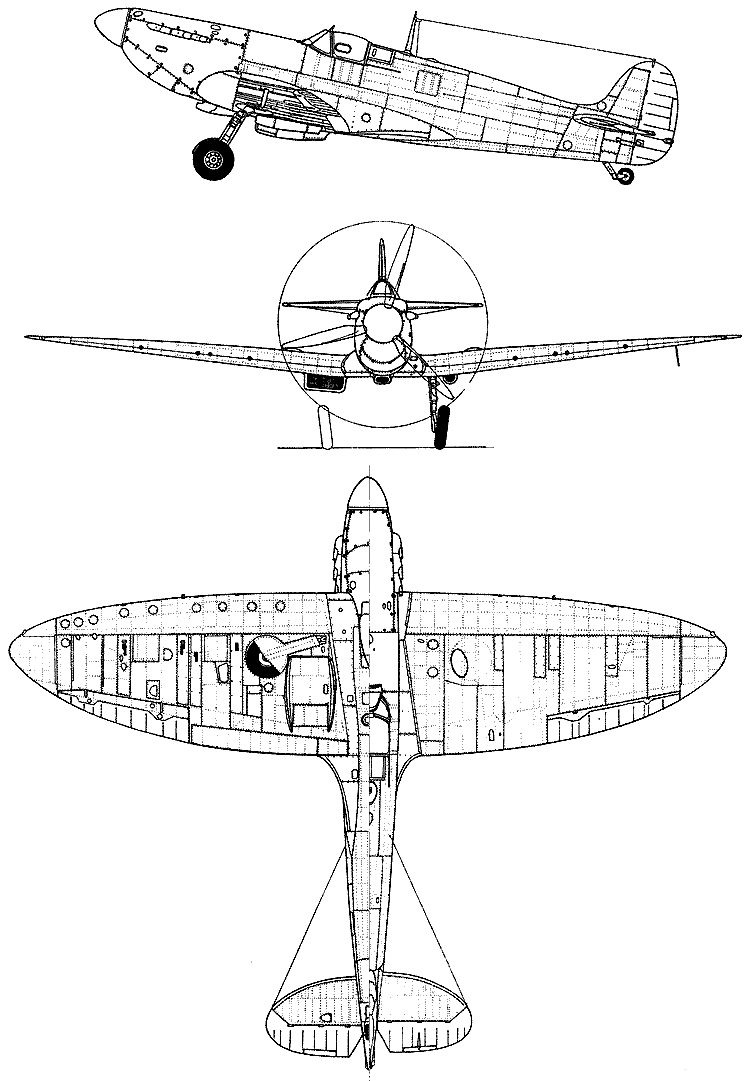First, something about the plane!
The Supermarine Spitfire first flew on March 5, 1936. In 1937, production of the Spitfire Mk I serial version began. It was based on the prototype machine. The wing structure was strengthened, the fuel supply was increased and the flap angle was modified. The drive was a Rolls-Royce Merlin II engine with a power of 1,030 HP and a two-bladed wooden propeller.
Two variations of the Mk I version were produced due to the two types of wings used. The Mk IA variant had A-type wings that allowed the machine to be armed with 8 7.7 mm Browning machine guns with a reserve of 300 rounds per km. The Mk IB variant had a B wing type, with armament of 2 20 mm cannons (60 rounds of ammunition per gun) and 4 7.7 mm guns (350 rounds per km). A total of 1,566 Spitfire Mk I aircraft were produced.
In 1940, the Mk II version appeared, powered by a twelve-cylinder V-piston Merlin XII engine. The engine is equipped with a mechanical compressor with boost pressure regulation with a power of 1,175 HP. The Spitfire Mk II was equipped with a three-blade variable pitch propeller of the de Havilland or Rotol type. Thanks to this, the maximum speed of the machine increased by 28 km/h and the climbing speed also increased. Depending on the design of the wing and the armament installed in it, two versions were produced: A and B.
And now about the models!
As I already had planes from one Polish fighter squadron, it was time for another one.
303 Squadron had a squadron code consisting of the letters RF.


Individual planes received the numbers, along with serial numbers:
R - P8361

J - P8085
T - P8346

In my opinion, these are not the prettiest models and maybe one day they will be "updated", but currently they occupy a significant place in my air force.
From the next entry, I will slightly change the publication method and the thread about aircraft units, models and structures will be placed in a shortened form in one post. Additionally, there will be a workshop thread and, as usual, the decal thread will remain :)
Na początek coś o samolocie!
Supermarine Spitfire został oblatany w dniu 5 marca 1936 roku. W 1937 przystąpiono do produkcji wersji seryjnej Spitfire Mk I. Bazowała ona ma maszynie prototypowej. Wzmocniono w niej konstrukcję skrzydła, zwiększono zapas paliwa oraz zmodyfikowano kąt wychylenia klap. Napęd stanowił silnik Rolls-Royce Merlin II o mocy 1030 KM oraz dwułopatowe drewniane śmigło.
Wytwarzano dwie odmiany wersji Mk I ze względu na dwa typy stosowanych skrzydeł. Odmiana Mk IA miała skrzydła typu A które pozwalały na uzbrojenie maszyny w 8 karabinów maszynowych Browning 7,7 mm z zapasem 300 pocisków na km. Odmianę Mk IB miała typ skrzydła B, w której uzbrojenie stanowiło 2 działka 20 mm (zapas 60 sztuk amunicji na działko) i 4 karabiny 7,7 mm (zapas 350 sztuk na km). Ogółem wyprodukowano 1566 samolotów Spitfire Mk I.
W 1940 pojawiła się wersja Mk II napędzana dwunastocylindrowym widlastym silnikiem tłokowym Merlin XII. Silnik wyposażono w mechaniczną sprężarkę (kompresor) z regulacją ciśnienia doładowania o mocy 1175 KM. Spitfire'a Mk II wyposażono w trójłopatowe śmigło o zmiennym skoku typu de Havilland lub Rotol. Dzięki temu prędkość maksymalna maszyny wzrosła o 28 km/h, wzrosła również prędkość wznoszenia. Zależnie od konstrukcji płata i zamontowanego w nim uzbrojenia wytwarzano dwie odmiany: A i B.
A teraz o modelach!
Jako, że już miałem samoloty z jednego polskiego dywizjonu myśliwskiego, przyszedł czas i na drugi. 303 dywizjon posiadał kod dywizjonowy składający się z liter RF.
Jako
wyróżnik polskiego dywizjony pod kabiną pilota malowano polską
"szachownicę", po za tym samoloty tej wersji nie posiadały żadnych
dodatkowych, indywidualnych malowań.
Poszczególne samoloty otrzymały natomiast numery, wraz z numerami seryjnymi:
J - P8085
M - P8079
R - P8361
T - P8346


.jpg)




Brak komentarzy:
Prześlij komentarz